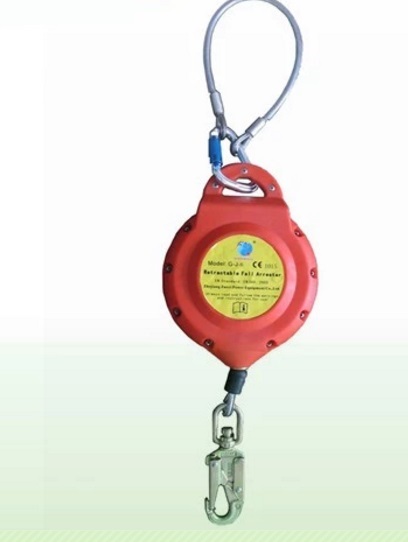
Rope Grab Safety Cather Self Retractable Fall Arrester Falling Protector
Keyword:Fall arrester Time:2019-11-8 19:50:05
The differential fall arrester gives you a sense of security
Fortunately, the differential fall arrester has become much safe because of it. It is an important part of mine hoisting system. Especially in the winding hoist system of vertical shaft, when the main hoisting rope breaks, the cage is braked on the braking rope smoothly to avoid the cage falling into the bottom of the well causing major safety accidents.
It consists of four parts:starting mechanism, transmission mechanism, capture mechanism and buffer mechanism. Among them, the starting mechanism is the action of the fall arrester when the main lifting rope is broken; the driving mechanism is the medium that transmits the action command of the starting mechanism to the executing mechanism; the catching mechanism is the key part of the fall arrester braking, responsible for braking the cage on the braking rope; the buffer mechanism can effectively reduce the large deceleration caused by sudden braking. It makes the braking process more stable.
At present, the differential fall arrester is precisely because of its sudden capture action, so that part of the kinetic energy can not be fully absorbed, and cause some harm to the human body. For this reason, the security industry has high technical requirements for fall arrester. It is required that the empty travel time should not be less than 0.25 seconds during decoupling test. Under small terminal load, the braking deceleration of cage should not be greater than 50 m/s.Under large terminal load, the braking deceleration of cage should not be less than 10 m/s.
At present, there are many studies on the method of decoupling test of speed difference fall arrester, but the comprehensive influence of braking distance and buffer distance on braking effect is less.Generally, braking deceleration is calculated indirectly according to the law of conservation of energy. Through the detailed analysis of the deceleration in the braking process, the influence of the buffer distance of the buffer rope on the whole braking is put forward.
Dynamic analysis of braking process assumes that the cage is braked downward at initial speed.The braking deceleration process should be divided into three main processes:
(1) The cage is subjected to gravity and makes free falling motion with initial velocity. When the starting mechanism moves, the starting spring moves the sliding wedge upward and tightens the brake rope. Because there is an allowable distance between the sliding wedge and the braking rope, which generally does not exceed 8 mm, the acting time of the spring force is the aerodynamic time.During this period, the cage is accelerated by gravity.
(2) The action process of the sliding wedge on the brake rope: Starting from the contact of the sliding wedge with the brake rope, because the friction between the metals is relatively small, the friction is increased by increasing the positive pressure between the two.Therefore, the force of the starting spring is also needed to make the sliding wedge press the brake rope tightly. Under the action of gravity and spring force, this process is very short. In order to facilitate calculation, we need to ignore the impact of braking deceleration on the whole process.
(3) Buffering process: the buffer acts to provide further braking power, the cage speed drops to zero, and the buffer rope is pulled out at a certain distance. In this process, the brake rope also has an elastic elongation, and this elastic elongation will change because of the length of the brake rope itself, the use time and wear conditions. Considering that this quantity has little influence on the deceleration rate considered in this paper, no specific analysis is made.This process will also produce a certain deceleration.


- No information
-
1. Design objective of electronic crane scale network management. (1) Adopt advanced distributed data processing techno…
-
Electronic crane scale bearing platform installation to focus Electronic crane scale can be installed generally on the li…


